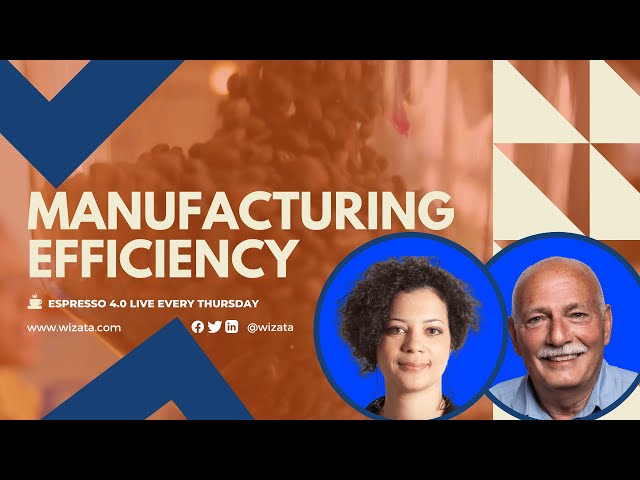![]() Espresso 4.0 by
Espresso 4.0 by
Wizata
In this Espresso 4.0 episode, we decided to do things differently. We have a double guest attack team with Crystal and Johan for the first time. Welcome to Espresso 4.0. Let's start by you talking about your background and why our viewers should listen to what you have to say.
I am Christele French, and I used to work for European manufacturers for about 18 years. I worked in marketing, communications, and sales, so I was business development oriented but always with one foot in production and technical to be able to explain the solutions to colleagues and customers.
I operated in Europe, Africa, Brazil, and French Overseas.
My name is Johan. I'm Danish. I have worked close to 40 years in the industry, coming from the financial corner, but I have used the last 35 years only in production. We will try to translate the knowledge of the practicalities we have from the production sites and combine this with a solution on digital.
That is why I brought you here because you have a well-rounded knowledge of all the processes that happen in the manufacturing facility. You've managed some of the manufacturing facilities and factories.
You've been in sales, you've been in marketing, and you've had the role of every stakeholder within the manufacturing company except being the actual operators. That's the only thing that you're missing in your portfolio.
New Solutions to Old Problems
Speed of Information
Having had the experience you've had in the manufacturing industry and running some of these facilities as well, what are some of the problems you've had in managing these facilities that would today be solved with digital solutions?
I would say some communication because to communicate better outside, you first need to communicate inside. So to improve the production processes first, then to improve the whole company processes and the whole business.
For example, the sales know exactly when the order is ready for their customers. If not, why, and what was the problem. And it can help HR as well.
I think the main purpose is speed. The further back you go in history, the longer you have to wait for some kind of report, some kind of update, some kind of warnings from the system. Using the digital method, you can have live data all the time, no matter where you are, in the form you want. And that's not only on the management level but also on the floor.
The fast transition of information can be a challenge in big companies. That means getting the information to the floor, so people there can make the correct decisions instead of talking to the boss who needs to talk to the boss.
And three days later, the guy on the floor got an answer to a question he could answer himself, but he’s not allowed to.
The speed of information is real-time right now. It's much more streamlined across all stakeholders. There's more transparency. And the idea at the end of the day is that whoever needs information can access it fast and have it in his hands basically with a click, whatever it may be, whatever his deliverables are, whatever is relevant for them.
Monitoring Assets with IoT
That is just one side. The other side is combining fast information and installing all kinds of sensors in your machines to let your machines talk, so to speak. This means that an operator can take care of a bigger number of machines than before. If something goes wrong with Machine Two while he's working on Machine One, he will get the information.
We're talking about IoT connecting different assets and having direct information from the assets themselves. For example, to know the temperature in a room, to know the vibration of the machine, or the, again, the temperature of the material.
But also getting the data from the It system, like the RP, CRM maintenance system, and whatever else, or even getting the data from an Excel sheet. It happens often in companies, especially the smaller ones, where one person has all the knowledge so that knowledge has to be put in an Excel sheet.
And then, we can also collect that relevant data or compare the historical data with the current one from the machines to help us understand whether we are going by the plan. If not, we can react fast enough with the right decisions and just guess our destiny anymore.
Permeating Problems of the Industry
Johan, you mentioned you have 35 years of experience, so you have seen how the manufacturing industry looked 35 years ago. What are some things that you think still permeate as a problem but could be easily solved with digital solutions today?
When you come to the point where the acceptance of sharing information is there, and you have the right culture in the company, and then again, using the digital possibility, it's still about speed.
You have all the knowledge and need to let the people who have worked on that machine for 30 years. They know exactly what's going on. But at the same time, having basic information immediately makes it much easier for them to do their job.
When you come out to these, be that SMEs or bigger companies, the first thing you need to find out is where they are today, what it takes to really make a digital implementation successful, and what their goals are.
You need to make some kind of status on where they actually are today, because it doesn't make any sense to give these people a Rolls Royce car if they cannot ride a bike. So they have to be ready to do this as well.
Digitalization Doesn’t Have to be a High Capital Investment
You mentioned SMEs, and one of my questions wants to touch on the topic of small and medium enterprises. When we talk about digitalization, there seems to be some kind of taboo stereotype that this is a high capital investment only reserved for those companies that can afford it.
But what can SMEs do? What benefits can they tap into even today with some low-cost solutions?
The point around the system is, first of all, not only us but also many of our colleagues and competitors out there are actually focusing a lot on SMEs and securing that there is no high investment upfront.
When we talk to them, they are a little afraid of how we can do this and what will happen. So if it's possible to install a system that gives them all this data availability just with a machine or two or three, don't do it the whole way around immediately because people also need to accept and understand this is not something we are doing to get rid of you.
This is a tool for you to make it much easier. Especially if you combine that with the situation, at least in many western European countries right now, where it's very difficult to find qualified people. This tool enables you to be able to produce more with the same amount of people, even at a more competitive price.
Let them start nice and slow, two, three machines, two, three people, and then they learn from there.
Setting a Goal
Being a small or a big company, the first thing you need to start is to have a goal. And we are helping them with defining the goal because sometimes they know they want to improve, to reduce costs, or have more productivity, but they don't really know much more.
First, we get them to have specific goals and then to have the plan to reach them. After that, as Johan said, we go step by step, in small steps. It is important to have the adoption of the people because that is the key to the process.
The Future of Tech
What is the recent tech innovation you saw or read about that you thought was quite interesting?
Last four or five years or six years, I always just let tech innovations sink in. And then if they're still here in a year, well, there might become something. I'm hoping I'll soon hear somebody saying that they have now commercialized hydrogen cars instead of electric ones because I don't really believe in them yet.
I don't know if you had a chance to go to Hanover mess this year - there were quite a few hydrogen-powered batteries, whether for cars or other stuff. So, they're working on it. Let's see if they commercialize it.



